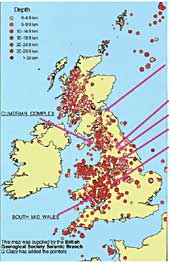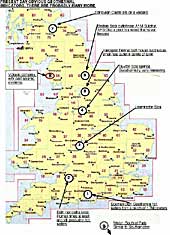OVERALL ASSESSMENT FOR AREAS OF
GEOTHERMAL INTEREST IN ENGLAND, WALES
AND SCOTLAND
The ongoing studies taking place are utilising Gravity and Magnetic implications, full chemical history of springs and wells, assessing their locations and proximity to proposed areas of interest shown from the present seismic maps from B.G.S. reports. Buxton and Harrogate have already been visited to gather available information
These studies will need to be followed up by Ground Noise Surveys. The acquisition of recorders to be converted for these surveys is also at an advanced stage. The amplifiers are also being considered. There do not seem to be any problems to progress to making a ground noise survey. Some input of capital is now becoming necessary to continue the good progress so far in collating the information available, to identify targets. It may be necessary to combine with a University or Government department, or find a private totally committed company to the project. Up to now, Harrogate and Buxton have been visited and, shortly, the mid South Wales area with the North Wales and Leamington Spa will receive a visit.
For the area outlined in the Cumbria Volcanic complex, there are possibilities at the South Western end and at the North Eastern end for geothermal accessible systems. For the South Western end the mountainous topography may not lend itself to easy access for survey, although not impossible. But, if the aquifer lies close to the confines of the valley, it will make everything simpler; this is probably the case. The North Eastern area will be much easier to survey. Hopefully there will be some surface indicators. Both areas have good access to the National Electricity Grid.
It could also be of interest to Bath and Southampton to locate the whereabouts of the source of their hot water supplier. This source looks as though it could be some distance from the drill termination. One could surmise that this hot water is supplied horizontally along underground layers. The location of the prime source will be of great benefit to the future of their projects.
This theory seems to apply to the Harrogate and Bedale source for its thermal waters, which seems to parallel the same kind of situation as for Bath and Southampton. There does not appear to be one outlet situated directly over these surface indicators. So this situation would call for a fairly wide noise survey to detect the source aquifers.
For Buxton East and West, Leamington Spa with the Cumbrian and Welsh systems, the common factors as seen at this time between all these areas identified in this report are: they appear to have a source supply not connected directly below the surface indicators; they seem to have underground systems which carry the geothermal waters to the surface. The only common denominator between all these systems is that they are all from volcanic activity. Only the mode of transport to the surface is different. There is always the possibility that the Bath and Southampton hot water supply, could share the same underground source, as could the Harrogate and Bedale one, but they may be fed from an underground fracture.
There are also areas in the Western Highlands in Scotland that show a few possibilities. Priorities as to the direction of the surveys, and the timing of them, will have to come from the investor assessing the results from surveys as they progress.
 |  | 
|
| Fig2 Click to enlarge | Fig1 Click to enlarge | Fig6 Click to enlarge |
It is now important for Southampton, Bath, Harrogate and Bedale to realise that their hot waters do not come directly beneath where their borehole or surface manifestations occur. It would be very prudent to find the source of their heat, which, as indicated by their published cross section, is fed from some place within their horizontal strata shown in their diagram (Fig7) below. The discovery of this source could possibly increase both their heat output in both quantity and temperature with an added longevity of supply. It would be very naive judging from their cross section to believe that their borehole was the end of the matter. Just extend the Model "a" outwards from the volcanic complex and you can come up with a multitude of ways for their water to be heated away from their borehole which apparently is fed horizontally.
| 
| Fig7 CROSS SECTION COPIED FROM SOUTHAMPTON'S GEOLOGIC REPRESENTATION OF THEIR BOREHOLE This is printed in their "Urban Community Heating and Cooling: the Southampton District Energy Scheme" booklet. |
THE VOLCANIC UNDERLYING PUZZLE
It is quite normal to have many unexplained mysteries attached to data that has been collected and represented to try and see why they occur. Recently while trying to determine areas of deep geothermal systems for the production of electricity from steam naturally produced in certain areas of the world, my first choice was where are all the surface hot waters are occuring in this country. This information was simple to map. My next quest was to contact the British Geological Societies Seismic unit in Edinburgh as they have very expertly paid a lot of attention to the many local earthquakes in the United Kingdom. The information which they kindly sent to me contained many maps and written dialogue of their work. In the text they pointed out to what they refer to as clusters of earthquakes which did not align themselves along obvious fault lines. There seems have have been no conclusive answer to this phenomenon, this attracted my attention because it was not the first time I had seen these clusters.
I would suggest that the clusters appear to be concentrated where large volcanic outpourings, which built our volcanic mountainous regions are. The evidence of our main hot springs showing at the surface shows that for a very long time thermal waters have been flowing to the surface. The outpourings of the volcanic materials on the surface suggest that large areas beneath these outpourings are still very active. The activity deep underground will have highs and lows producing stresses on the solidified ground above this deep activity (figure "8"). In turn this would produce stresses that produce these clustered earthquake zones. If this is the case then my model (figure"9") of the hot aquifer system becomes more believable than ever.
The water at Southampton has been coming up at the same temperature for over a decade. I believe this indicates that the main heat source is massive and effectively inexhaustible. With the equipment I designed, I believe that I can locate the main heat source(s). At Southampton the water is merely warm and has to be pumped out. At the main heat source, the water will be so hot that it will come out under high pressure, requiring no pumps and providing an unbelievably powerful source of energy.
Gresham R.T.Clacy. Geophysicist.
Contact Form
Finally, here is the UK Government's response to my proposal:
| 18 May 2007 Thank you for your letter of 5 March to David Miliband, enclosing correspondence from your constituent, Mr Gersham [sic] Clacy, about geothermal energy and his proposal for a UK survey of the resource potential. I am replying as this matter falls within my portfolio and apologise for the delay in doing so. As Mr Clancy [sic] points out, there are a number of regions across the UK where aquifers exist and they form an important source for ground water. In some regions, formation water becomes naturally heated and in these circumstances water can be used as a heat transfer medium, particularly where there is a large demand for heat. There are many regions in Europe and across the world where the geothermal gradient is much higher than in the UK, making geothermal energy viable. However, the development of geothermal energy from aquifers depends on the quality of the resource, which is dependent on a number of factors including permeability, surface temperature, sustainability of flow and the proximity of the demand for heat. The Government is aware of the potential for geothermal energy in the UK, spending around £50M between the mid 1970's and 1994 on a programme to determine the extent of the resource and its economic viability. This included a national appraisal of geothermal energy from permeable rock formations (aquifers) in order to provide a definitive statement of its potential and to determine whether aquifers could be developed in the UK. The conclusions of this work where [sic] published in 1986. The results revealed that the resource was limited either because surface temperatures or permeability were lower than expected. Only one area, underlying Southampton, was sufficiently promising and consequently a demonstration scheme was established. Geothermal energy is an established technology. Techniques used in the oil industry are used to identify where suitable rock formations occur. It is therefore possible for developers to reappraise prospective regions for development. It must be stressed that geothermal energy in the UK is only suitable for heat as surface temperatures are too low for electricity generation. Developers would also need to identify suitable heat demand for the resource, which must be close to the wells drilled. Most areas identified in the UK are not close to major centres of population and are therefore unlikely to be economically viable. Therefore the Government is currently not funding any major research into geothermal energy as unless the technical, practical and economic constraints identified under the previous Geothermal Programme can be addressed, the prospects for geothermal power in the UK would appear to be limited. Lord Truscott
Parliamentary Under Secretary of State for Energy |
Continued on Page 3
Free energy from the earth. Geothermal energy can be tapped either at or near the surface at a random point where hot water emerges, or from magma miles below the Earth's surface. The original programme looked at surface sources but ignored the possibility of a magma intrusion creating a high energy source. This is what we must investigate as a matter of urgency if our reliance on coal, oil and reactors is to be reduced.
Further reading
http://freeenergynews.com/Directory/Geothermal/index.htm
http://pesn.com/2007/01/22/9500449_MIT_Geothermal_Report/
Gresham R.T.Clacy. Geophysicist.
Contact Form
Copyright ©2007 SatCure & GRT Clacy
Updated June 5, 2007
This file may be downloaded for private and personal use but NO part of it may be published in any form without the prior permission of the author.






